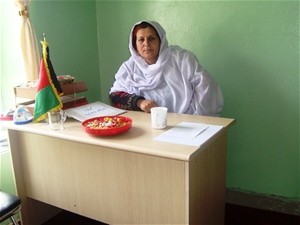
Mrs. Pashtoon Shana has been the principal of Girls School No. 2 in Fayzabad, Badakhshan Province, since 1994. Today, the school enrolls 1,280 girls in grades 1-12.
USAID/AIRP
USAID road creates better educational opportunities in Badakhshan Province.
23 JUNE 2010 | FAYZABAD, AFGHANISTAN
The new 103-kilometer road from Kishim to Fayzabad is bringing new business and investment to Badakhshan Province. Built through USAID’s Afghanistan Infrastructure Rehabilitation Project, the Kishim to Fayzabad Road is a vital link in the transportation network connecting Badakhshan to the rest of Afghanistan. Residents also see that the road facilitates educational opportunities for students, connecting them to schools and universities in their province and beyond.
One of the most optimistic residents is Mrs. Pashtoon Shana, the principal of Girls School No. 2 in Fayzabad. The school was originally a primary school. However, because of the new road, more students are able to get to the school and it now enrolls more than 1,200 girls in grades one through 12. Presiding over the school since 1994, Mrs. Shana has overseen many positive changes and has inspired the community to do as much as it can to serve students.
As the number of students attending Girls School No. 2 increased, the community decided to build a school for boys. Today, the boys’ school has nine grades.
Unfortunately, because there is no university in the province, graduates of Badakhshan’s high schools must go elsewhere to receive higher education. For years, the absence of a serviceable road complicated matters even further. “Our students who went to Kabul had no money, and parents spent so much time and money on transportation that the funds they had remaining to give students were greatly reduced,” Mrs. Shana said. “Now, we can send more money since it costs so little to travel.”
The provincial government plans to construct additional connecting roads branching out from the provincial center. These roads connect districts to each other and allow teachers and materials to reach children who still live in isolated villages.
No one is more hopeful for the future than Mrs. Shana, whose attentive teaching has produced engineers and doctors who live and work in Fayzabad. “Where there is a road,” she asserted, “there is development. We will see a difference.”







Comment
Make a general inquiry or suggest an improvement.